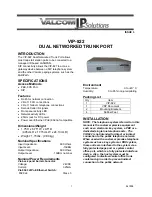
4 Deployment Procedure
The deployment procedure for establishing a wireless system is as follows.
Note
The deployment procedures of "5. Configuration" and "6. S-PS Registration" in "4.1 Overview" differ from
each other depending on the SIP server (KX-NS1000 or third party SIP server) used in the system.
Conditions for Configuring the Air Synchronisation
Notice
For General Networking
•
A static IP address is required for the Super Master CS.
For Wireless Networking
•
Do not locate SIP-CS belonging to different air synchronisation groups in the same area.
•
The SIP-CS assigned as the Super Master CS or the Master CS for each air synchronisation group
should be located in the three dimensional centre of the installation site.
•
Radio signals from other wireless devices can affect Air synchronisation and communication between
SIP-CSs and S-PSs.
Required Distances between Equipment
CAUTION
Maintain the distances listed below between equipment in order to prevent noise, interference or the
disconnection of a conversation. (The distance may vary depending on the environment.)
Equipment
Distance
SIP-CS and office equipment such as a computer, telex,
fax machine, etc.
More than 2 m
SIP server and SIP-CS
More than 2 m
SIP-CS and other radio device
More than 5 m
Notice
If multiple SIP-CSs provide service in the same area, the phone connection may become noisy or the
number of possible simultaneous calls with S-PSs may decrease due to interference between the SIP-CSs.
The required distance between SIP-CSs may vary depending on the environment of the installation site
and conditions in which the wireless system is used. Conduct a site survey to determine the appropriate
distance.
4.1 Overview
1. Site Planning
Choose the optimal installation locations for SIP-CSs. Site planning requires careful preparation and thorough
testing.
2. Site Survey
Confirm the signal condition of the planned location using two un-registered CSs and one S-PS.
22
Installation Guide
4 Deployment Procedure
















































